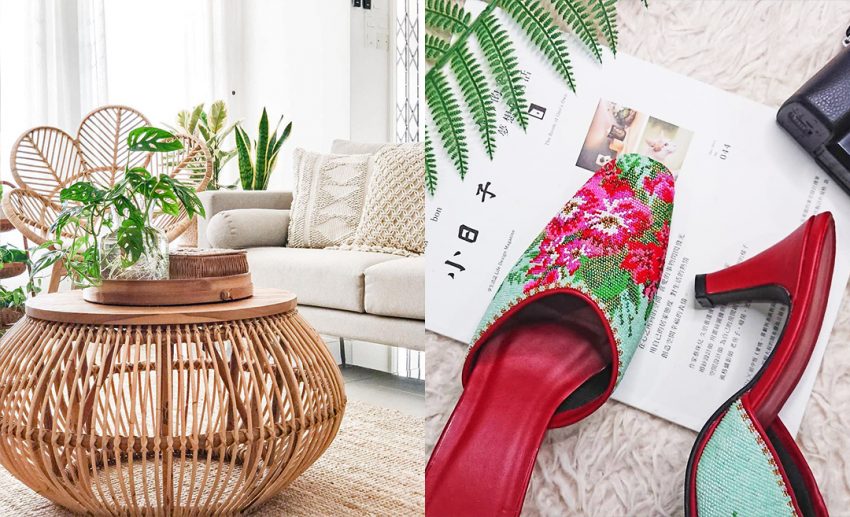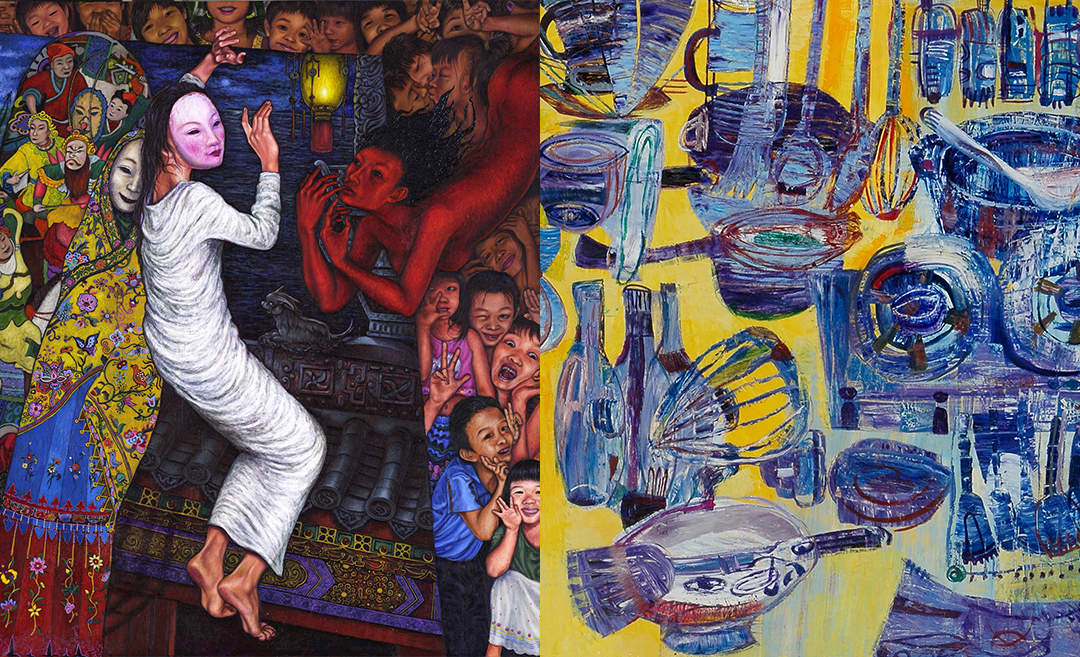
Intertwined within the deeply colourful fabric of our beloved rojak (colloquial term for ‘eclectic blend’) society is our über rich heritage art scene. This includes intricate and expert craftsmanship and live performances that have been passionately practiced and dedicatedly preserved for centuries.
But with a diverse ethnic mix and even larger tally of sub-groups scattered across the country, where does one even begin to acquire a clear picture of our numerous states and federal territories’ art history?
Don’t worry, we’ve gladly done the legwork for you to create a comprehensive crash course highlighting the most emblematic art forms from each state. Before diving in, may we point out that selecting just ONE of them to fairly represent each region was an insane mammoth of a task. Nevertheless, prepare to absorb and appreciate our ancient artistry:
Perlis: Awang Batil
Remember when your parents used to read aloud your favourite fantasy chronicles before bedtime? It can be argued that this is rather similar, granted to a more ambitious extent. As a traditional genre of musical storytelling, awang batil involves a solo performer narrating stories whilst beating on a batil (brass bowl) or belanga (pot).
On top of that, auxiliary instruments such as the serunai (oboe), rebana (tambourine), violin, and gendang terinai (two-sided drum) can be thrown into the captivating performance. Donning both the Hulubalang and Wak Nujum masks for dichotomous character switch-ups during the course of reciting classical Malay fables is also a must. Considering that one session alone can go on for days, we’ll gladly give a standing ovation to the commitment given alone.
Kedah: Mek Mulung
Incorporating an eclectic mix of dialogue, dance, music, and song is none other than mek mulung — a traditional Malay theatre performance. Sticking to the archaic acting codes of yesteryear, an all-male cast conjointly undertakes the task of portraying their female counterparts. Ironically, ‘mek’ is the Kedahan slang for ‘girls’.
Once the curtains are up, the bertabuh ritual (percussive orchestra) begins with the help of a rebana, serunai, gong, and kecerek (concussion sticks) along with soothing group vocals. Subsequently, expect crudely animated dance movements accompanied with dialogue and poetry from a repertoire of stories inspired by local legends. Did we mention that it can take up to three nights to round up the tale? *cue shocked but impressed gasp*
Penang: Rattan Weaving
From rocking chairs and tables to baskets and stools (and even bird cages), the art of rattan weaving was once a demanding venture across the region. Some could say it was an unsurprising trend, considering it is an abundant and sustainable native species.
Also known as climbing palms, rattan furniture was sought out for its durability, robustness, and suitability for tropical climates. Before jumping into the weaving process, they are completely soaked in water to boost flexibility before transforming into a sturdier, tighter version upon drying. Apart from antique household items, pretty handicrafts (including handbags) and tableware are also made fastidiously.
Perak: Labu Sayong
While it can be kept as decorative homeware, don’t let the classical beauty of the labu sayong fool you into thinking that it’s all style and no substance. This curvy gourd-shaped vessel, moulded from clay, was initially invented as a pitcher to store water. Thanks to its slightly porous nature, it has the added knack of cooling any liquid poured inside — how nifty!
The trick to spotting an authentic one is the colour. Discarded rice husks from Perak’s specific type of paddy field are rolled over the sculpted pottery to convert its orange shade into an ebony one once forged in intense flames. Other than conscientious shaping, embossing and floral carvings are added on to enhance its endearingly whimsical form.
Kelantan: Wayang Kulit
Directly translating to ‘shadow/theatre skin’, wayang kulit is actually a lot less nefarious than it sounds. Instead, it’s a rather mesmerising shadow puppet show that originated from Indonesia. However, the Kelantanese version is supposedly brought over from Cambodia.
Projected on a stretched linen screen with the help of natural light sparked from oil lamps or electric lights, the dalang (shadow puppeteer) sits calmly behind it and manually manipulates the movements of the decorated carved figures made from leather.
As the good old fashioned tale of hero versus villain never fails to please an eager crowd, the major Indian sagas referred to as Ramayana and Mahabharata are depicted with such gusto. The addition of traditional musical instruments such as rebab (bow string instrument), canang (small dual gongs), gendang (two headed drum), and serunai playing in the background further enhances the immersive experience.
Terengganu: Batik
Can you even declare yourself a true Malaysian if you’ve never even heard of this gorgeous fabric (or own a single piece of it)? Instantly discernible from the splashy tones and floral patterns, batik is a wax-resistant fabric dyeing technique that undergoes a repetitious process of waxing, dyeing, and boiling. In other words: the greater the tally of bright colours, the greater the amount of effort injected into the delicate process.
Although imported from our Javanese cousins, we’ve adapted the design into our own with larger floral motifs and more vibrant tones using either the hand-drawn or block-stamped method. These days, you can even find batik being used in modern clothing.
Pahang: Tenun Pahang Diraja
Worthy enough to literally grace royalty, Tenun Pahang DiRaja is an undoubtedly luxurious type of woven silk fabric that feels just as exclusive as it appears. Standing out from the crowd of its various distinctive silky cousins, this particular one is notably stitched with an amalgamation of chequered and striped patterns in muted yet multihued tones.
Created with the help of a yarn separating apparatus and mesin kek (weaving machine), these handwoven textiles are also embroidered with dozens of metallic-threaded colek (small dotted floral ornament).
If you’re wondering about the royal connection, this preserved art form struck the attention and soon entered the wardrobes of the royal princess of Pahang back in 2005. A year later, it attained the royal status of ‘DiRaja’, bestowed upon by the state’s then crown prince.
Selangor: Manpaanai
One fundamental earthenware kept with the utmost care in any authentic Indian household is the cherished manpaanai. It’s also faithfully whipped out or repurchased during Pongal — the thanksgiving festival celebrating a successful harvest.
Made with the foundational element of fresh clay, the specific variety used (ball clay is one of them) and the choice to sprinkle in additional ingredients such as sand and flour depend entirely on each potter. Once moulded, it is dried under the scorching sun for at least eight hours before getting baked in a blazing boiler for another 10 hours or so. Then comes the extra artistic part: painting the clay pot with vibrant flowers or rangoli patterns seen on kolams (decorative art using rainbow-coloured rice).
Negeri Sembilan: Rumah Gadang
Although most of us may refer to this iconic architectural wonder as ‘rumah Minangkabau’, it is actually known as rumah gadang, or even rumah bagonjong. However, the layman’s term isn’t that far off as this magnificent style is emblematic of the Minangkabau settlement.
Traditionally constructed as a large communal home with shuttered windows built into walls engraved and painted with plenty of intricate floral patterns, this wooden home is easily recognisable by its sweeping, protruding ‘buffalo horn’ roof feature. Considering their property inheritance custom follows a matrilineal system, it is believed that the number of horn-like extensions are equal to that of married daughters living in a household. This may explain the occasionally unbalanced look of the roof.
However, Malay influences may have led to a less curved roof with blunter ridges. Nowadays, this elaborate design can be seen in modern establishments from government offices to luxurious hotels.
Federal Territory of Kuala Lumpur: Pewterware
Courtesy of the tin rush that pervaded every mineable spot in the Klang Valley, the illustrious metal alloy known as pewter was soon discovered. Not to be confused with silver, this precious metal is made from tin, copper, and antimony.
Apart from possessing a malleable property for a comparatively easy breezy sculpting process, the corrosive-free final product is assured to keep a showroom-worthy appearance for decades to come. From elegant tableware to refined decorative gifts, choose from a selection of polished finishes including soft satin lustre, dazzling shine, and subdued ‘antique’.
Melaka: Nyonya Beaded Shoes
As the name implies, a dazzling pair of Peranakan (community descended from Chinese immigrants tying the knot with Malayan locals) beaded shoes is deeply rooted in the culture it is named after. Fair to say, these status symbols are also called manek eh in Hokkien.
Hand-sewing a kaleidoscopic mix of manek potong (minuscule cut glass beads) with zen-like patience that can rival a monk’s, symbolic Chinese fauna and even English-inspired blooms are generally the go-to designs adorning different shoe cuttings. Choose from closed-toe, peep-toe, criss-cross, and the modern single strap. Whichever you prefer, these vintage kicks are guaranteed to be a one-of-a-kind.
Johor: Kuda Kepang
Integrating unquestionably grander versions of the makeshift horses from Monty Python and The Holy Grail, kuda kepang is a traditional war-themed dance that has undoubtedly become synonymous with this Southern state. It is typically performed by nine male dancers seated astride a vividly decorated two-dimensional horse made from pleated rattan or cowhide. Illustrating the horseback-ridden Nine Saints of Wali Songo who were credited for spreading Islam across Jawa, the dramatised battles fought by these legendary figures are reenacted at the helm of the whip-clad danyang (lead dancer).
Additionally, they are accompanied by the bujang ganong (masked dancer) and barongan (dancers portraying different animals), along with a melodious percussion beats created by the gong, angklung (bamboo percussion instrument), kenong (Javenese gamelan), and gendang. Moreover, it remains as a customary fixture during opulent soirées — including royal birthday celebrations for the Sultan of Johor.
Sabah: Tarian Sumazau
Mimicking the flying motions of the majestic eagle, the balletic tarian sumazau is dearly regarded as the national dance of Sabah. Mirroring the redundancy of chai tea, ‘sumazau’ quite literally translates to ‘dance’. It is also referred to as sumayau, mongigol, and maragang among the tribes.
Although there are several versions of this tradition, the one that instinctively springs to the outsider’s mind is the classic Kadazan Penampang, danced by couples to the gandang beat of hanging gongs and drums orchestrated by the sompogogungan (musical band). Established by the Kadazandusun tribe, this dance is traditionally performed barefoot in most cultural events including wedding ceremonies, religious rituals, and festivals — especially during Pesta Kaamantan (harvest festival).
Sarawak: Pua Kumbu
Associated with the Iban society, pua kumbu is a charming multicoloured woven textile patterned with complex spiritual motifs that have become the identifying image of the region. Although they may look like geometrics and swirls to the untrained eye, master weavers have revealed that these detailed designs are sent by divine intervention through dreams or visions.
Using a combination of backstrap looms and ikat dyeing (using natural dyes from locally grown plants), cultural elements such as engkaramba (anthropomorphic figures), flora and fauna, as well as Iban daily rituals are woven into the fabric. Regardless, the final outcome is deemed absolutely sacred and often turned into ceremonial garments. Not only does it act as a protective talisman, but it guarantees a bountiful seasonal harvest for the fortuitous wearer.



